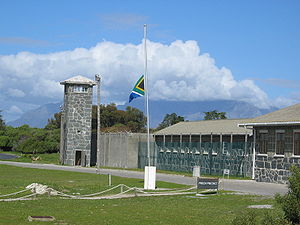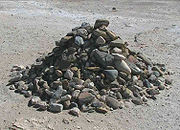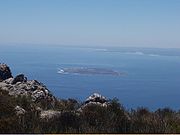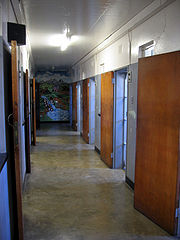
Robben Island
About this schools Wikipedia selection
SOS Children made this Wikipedia selection alongside other schools resources. All children available for child sponsorship from SOS Children are looked after in a family home by the charity. Read more...
| Robben Island | |
|---|---|
| Name as inscribed on the World Heritage List | |
 Prison buildings on Robben Island. Table Mountain is visible 15 km in the background |
|
| Country | South Africa |
| Type | Cultural |
| Criteria | iii, vi |
| Reference | 916 |
| UNESCO region | Africa |
| Coordinates | 33.806734°S 18.366222°E Coordinates: 33.806734°S 18.366222°E |
| Inscription history | |
| Inscription | 1999 (23rd Session) |
Robben Island (Afrikaans: Robbeneiland) is an island in Table Bay, 6.9 km west of the coast of Bloubergstrand, Cape Town, South Africa. The name is Dutch for "seal island". Robben Island is roughly oval in shape, 3.3 km long north-south, and 1.9 km wide, with an area of 5.07 km². It is flat and only a few metres above sea level, as a result of an ancient erosion event. The island is composed of Precambrian metamorphic rocks belonging to the Malmesbury Group. It is of particular note as it was here that past President of South Africa and Nobel Laureate Nelson Mandela and past South African President Kgalema Motlanthe, alongside many other political prisoners, spent decades imprisoned during the apartheid era. Among those political prisoners was current South African President Jacob Zuma who was imprisoned there for ten years.
History
Since the end of the 17th century, Robben Island has been used for the isolation of mainly political prisoners. The Dutch settlers were the first to use Robben Island as a prison. Its first prisoner was probably Harry die strandloper in the mid-17th century. Amongst its early permanent inhabitants were political leaders from various Dutch colonies, including Indonesia. After a failed uprising at Grahamstown in 1819, the fifth of the Xhosa Wars, the British colonial government sentenced African leader Makanda Nxele to life imprisonment on the island . He drowned on the shores of Table Bay after escaping the prison.
The island was also used as a leper colony and animal quarantine station. Starting in 1845 lepers from the Hemel-en-Aarde (heaven and earth) leper colony near Caledon were moved to Robben Island when Hemel-en-Aarde was found unsuitable as a leper colony. Initially this was done on a voluntary basis and the lepers were free to leave the island if they so wished. In April 1891 the cornerstones for 11 new buildings to house lepers were laid. After the introduction of the Leprosy Repression Act in May 1892 admission was no longer voluntary and the movement of the lepers was restricted. Prior to 1892 an average of about 25 lepers a year were admitted to Robben Island, but in 1892 that number rose to 338, and in 1893 a further 250 were admitted.
During the Second World War the island was fortified and guns were installed as part of the defences for Cape Town. It was also used as a prison.
In the South African general election, 2009, the Democratic Alliance won the island.
Maritime peril
Robben Island and nearby Whale Rock have been the nemesis of many a ship and its crew. The surf of the open Atlantic Ocean thunders continuously at its margins and any vessel wrecked on the reefs offshore is soon beaten to pieces and disappears. In the latter half of the 17th century a Dutch ship laden with gold coins earmarked for the payment of the salaries of employees of the Dutch East India Company in Batavia (now Jakarta, Indonesia) disintegrated on these reefs a short distance offshore, in relatively shallow but very restless waters. The gold today would be worth tens of millions of pounds sterling or U.S. dollars. A few coins have washed ashore over the centuries but the treasure itself remains in the ocean. It is protected largely by the almost ceaseless and violent surf. Many other vessels have been wrecked around the island.
Robben Island lighthouse
Jan van Riebeeck first set a navigation aid atop Fire Hill (now Minto Hil,), the highest point on the island. Huge bonfires were lit at night to warn VOC ships of the rocks that surround the island. The current Robben Island lighthouse, built on Minto Hill in 1864, is 18 metres (59 ft) high and was converted to electricity in 1938. It is the only South African lighthouse to utilise a flashing light instead of a revolving light. Its light is visible for 24 nautical miles.
Moturu Kramat
The Moturu Kramat, a sacred site for Muslim pilgrimage on Robben Island, was built in 1969 to commemorate Sayed Abdurahman Moturu, the Prince of Madura. Moturu, one of Cape Town's first imams, was exiled to the island in the mid-1740s and died there in 1754. Muslim political prisoners would pay homage at the shrine before leaving the island.
Animal life
When the Dutch arrived in the area in 1652, the only large animals on the island were seals and birds, principally penguins. In 1654, the settlers released rabbits on the island in order to provide a ready source of meat for passing ships. The original colony of African Penguins on the island was completely exterminated by 1800. However the modern day island is once again an important breeding area for the species after a new colony established itself there in 1983. The colony has grown to 13,000 and is now the third biggest for the species. The penguins are easy to see close up in their natural habitat and are therefore a popular tourist attraction.
Around 1958, Lieutenant Peter Klerck, a naval officer serving on the island, introduced various animals. The following extract of an article, written by Michael Klerck who lived on the island from a young age, describes the fauna life there:
| “ | My father, a naval officer at the time, with the sanction of Doctor Hey, director of Nature Conservation, turned an area into a nature reserve. A 'Noah's Ark' berthed in the harbour sometime in 1958. They stocked the island with tortoise, duck, geese, buck (which included Springbok, Eland, Steenbok, Bontebok and Fallow Deer), Ostrich and a few Wildebeest which did not last long. All except the fallow deer are indigenous to the Cape. Many animals are still there including three species of tortoise—the most recently discovered in 1998—two Parrot Beaked specimens that have remained undetected until now. The leopard or mountain tortoises might have suspected the past terror; perhaps they had no intention of being a part of a future infamy, but they often attempted the swim back to the mainland (they are the only species in the world that can swim). Boats would lift them out of the sea in Table Bay and return them to us. None of the original 12 shipped over remain, and in 1995, four more were introduced—they seem to have more easily accepted their home as they are still residents. One resident brought across a large leopard tortoise discovered in a friend's garden in Newlands, Cape Town. He lived in our garden and grew big enough to climb over the wall and roam the island much like the sheep in Van Riebeeck's time. As children we were able to ride his great frame comfortably, as did some grown men. The buck and ostriches seemed equally happy and the ducks and Egyptian Geese were assigned a home in the old quarry, which had, some three hundred years before, supplied the dressed stone for the foundations of the Castle; at the time of my residence it bristled with fish. Recent reports in Cape Town newspapers show that a lack of upkeep, a lack of culling, and the proliferation of rabbits on the island has led to the total devastation of the wildlife; there remains today almost none of the animals my father brought over all those years ago; the rabbits themselves have laid the island waste, stripping it of almost all ground vegetation. It looks almost like a desert. A reporter from the broadcasting corporation told me recently that they found the carcass of the last Bontebok. |
” |
There may be 25,000 rabbits on the island; they are being hunted and culled to reduce their numbers.
List of former prisoners held at Robben Island

- Autshumato, one of the first activists against colonialism
- Dennis Brutus, former activist and poet
- Patrick Chamusso, former activist of the African National Congress
- Laloo Chiba, former accused at Little Rivonia Trial
- Eddie Daniels, author and activist
- Jerry Ekandjo, Namibian politician
- Nceba Faku, former Metro Mayor of Port Elizabeth
- Petrus Iilonga, Namibian trade unionist, activist and politician
- Ahmed Kathrada, former Rivonia Trialist and long-serving prisoner
- Langalibalele, one of the first Activists against colonialism
- Mosiuoa Lekota, imprisoned in 1974, President and Leader of the Congress of the People
- Mac Maharaj, former accused at Little Rivonia Trial
- Makana, one of the activists against colonialism
- Nelson Mandela, African National Congress leader and former President of South Africa
- Gamzo Mandierd, activist
- Jeff Masemola, the first prisoner sentenced to life imprisonment in the apartheid era
- Amos Masondo, current Mayor of Johannesburg
- Michael Matsobane, leader of Young African Religious Movement. Sentenced at Bethal in 1979; released by PW Botha in 1987.
- Chief Maqoma, former chief who died on the island in 1873
- Govan Mbeki, father of former President of South Africa Thabo Mbeki. Govan was sentenced to life in 1963 but was released from Robben Island in 1987 by PW Botha
- Wilton Mkwayi, former accused at Little Rivonia Trial
- Murphy Morobe, Soweto Uprising student leader
- Sayed Adurohman Moturu, the Muslim Iman who was exiled on the island and died there in 1754
- Griffiths Mxenge, a South African Lawyer and member of the African National Congress
- Billy Nair, former Rivonia Trialist and ANC/SACP leader
- M. D. Naidoo, a South African lawyer and member of the African National Congress
- John ya Otto Nankudhu, Namibian liberation fighter
- John Nkosi Serving life but released by PW Botha in 1987
- Nongqawuse, the Xhosa prophet responsible for the Cattle Killing
- Maqana Nxele, former Xhosa prophet who drowned while trying to escape
- George Peake
- John Nyathi Pokela, co-founder and former chairman of the PAC
- Joe Seremane, current chairperson of the Democratic Alliance.
- Tokyo Sexwale, businessman and aspirant leader of the African National Congress
- Gaus Shikomba, Namibian politician
- Walter Sisulu, former ANC Activist
- Robert Sobukwe, former leader of the PAC
- Andimba Toivo ya Toivo, Namibian politician
- Jacob Zuma, President of South Africa and leader of the African National Congress



